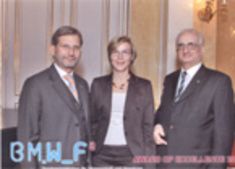Verleihung des "Award of Excellence" 2008
Mit der neu geschaffenen Auszeichnung des BMWF soll die Arbeit junger Wissenschaftlerinnen und Wissenschaftler besonders gewürdigt und die Öffentlichkeit auf die herausragenden Leistungen und deren gesellschaftliche Bedeutung aufmerksam gemacht werden. Insgesamt wurden 28 Dissertationen aller Universitäten und Fachbereiche aus ganz Österreich geehrt. Im Vorfeld waren die Rektorin bzw. die Rektoren aufgerufen, „herausragende und best beurteilte“ Doktorarbeiten ihrer Einrichtung zu nominieren. Die preisgekrönte Dissertation “Cellulose analytics by fluorescence labelling and gel permeation chromatography: Description of degradation processes, evaluation of stabilisation procedures and development of a non-destructive alternative” wurde unter Betreuung von A.Prof. Dr. Antje Potthast am Department für Chemie (Organische Chemie / Holz-, Zellstoff- und Faserchemie) durchgeführt. Prof. Gerhard Banik, Staatliche Akademie der Bildenden Künste Stuttgart, fungierte als Zweitbetreuer und externer Gutachter. Frau Dr. Henniges setzt ihre wissenschaftliche Karriere als wissenschaftliche Mitarbeiterin und Expertin für restauratorische Fragestellungen im Christian-Doppler-Labor „Advanced cellulose chemistry and analytics“ am Department für Chemie fort.
Kurzbeschreibung der Dissertation (englisch)
Cellulose analytics by fluorescence labelling and gel permeation chromatography: Description of degradation processes, evaluation of stabilisation procedures and development of a non-destructive alternative The analysis of historical papers is a requirement to estimate their actual condition, to elucidate underlying degradation mechanisms and to design appropriate treatments. Fluorescence labelling of cellulose functionalities followed by gel permeation chromatography yields highly sensitive information about the extent of oxidation and chain scission in cellulosic materials. Additionally, only few milligrams of sample are needed which allows for sampling on selected original materials. These features make fluorescence labelling very attractive for the analysis of topics in the context of paper conservation. Degradation processes of historic papers, their general condition in terms of average molecular weight and oxidized functionalities, the extent of oxidation and hydrolysis triggered by transition metal ions contained in pigments or inks and wet-dry interfaces formed after local wetting of paper are described on the basis of the chosen analytics on model papers and original sample material. Various possibilities to treat some of the above described degradation processes are presented. In this work the efficiency of combined calcium phytate/ calcium hydrogen carbonate treatment to inhibit degradation caused by transition metal ions and paper deacidification on an industrial scale to prevent acid hydrolysis were investigated. The comparison between sample materials and historic paper samples is emphasized. Typical 19th and 20th century ground wood papers are difficult to analyze due to their limited solubility in N,N-dimethylacetamide/ lithium chloride needed prior to gel permeation chromatography. Several advances to improve their solubility are described. A multivariate calibration approach based on fluorescence labelling data and near infrared spectroscopy is discussed in the present work to avoid micro-destructive sampling on historic originals.

